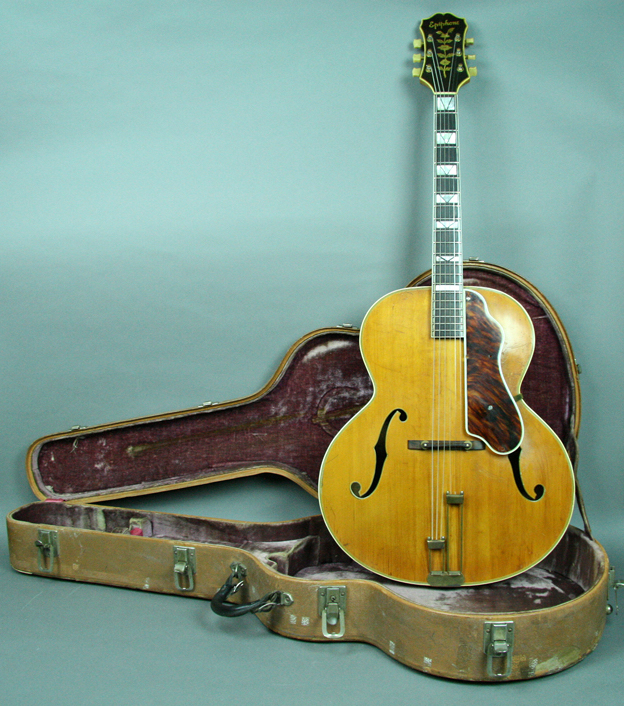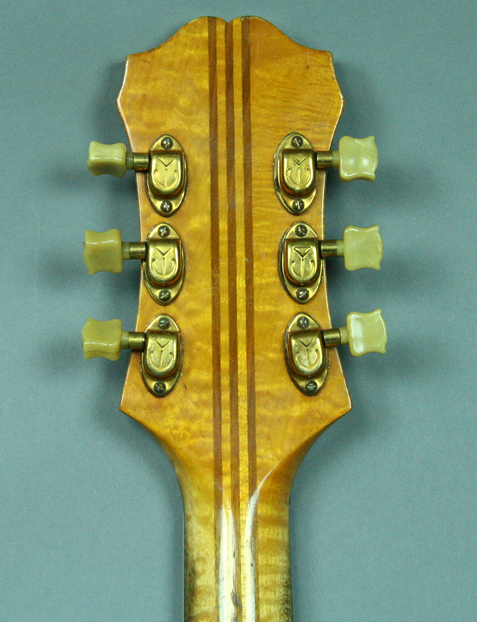
Close-up #15: 1941 Emperor SN 18233
This gorgeous archtop was offered for sale a while ago – I saved pics from the online listings, no other affiliation.
Epiphone introduced the Emperor in fall 1935 as their new top model with a huge 18.5" wide body – to compete with Gibson's recently launched Super 400 model. This example bears a "Masterbilt" type label with typed SN 18233. (In this SN range we would actually expect to see a "green" type label; this typed SN Masterbilt label is likely a replacement applied during a repair at the Epiphone factory, as explained in this story).
According to our research this SN indicates a manufacturing date of c. late 1941 (although dated to 1943 by older sources). Whatever – fact is that 18233 is the highest known serial number of a pre-WW2 Emperor!
From what we know today, Epiphone halted production of their high-end Emperor and DeLuxe models (and electric instruments) during the war years. The next following batch of Emperors was started after the war in 1945, the first documented SN is 52831.

Since its introduction in 1935, the Emperor model underwent several cosmetic changes. The earliest version had very long (7.5") f-holes which ran almost parallel to the strings, while by c. 1938 the were about 1/2" shorter and placed more angled. Interestingly, you can see this evolution in the 1942 catalog images (pictured below) – compare the f-holes of the sunburst finish version with the natural finish version on the right.

The natural or "blonde" finish option was introduced around 1938 and first cataloged in 1939. The price of $400 included a fine, leather-covered case with silk plush lining. Note details like the form-fitting around the heel (see top image).
Especially the headstock design details kept changing during those years: Like on all Epiphone models, center-dip headstocks replaced the trademark asymmetric headstock shape by 1939 – possibly another Gibson influence(?). The Emperor at least kept its distinctive "clipped" top corners!

The headstock inlays were more and more simplified over the years (a cost-saving measure I suppose): By the time this example was produced, the blossom branch had lost two of its leaves (see this 1935 example for comparison). However note that the leaves still show delicately engraved veins – a detail missing on all post-war examples. Most pre-war Emperors have a pearl triangle inlaid above the nut – except examples from the last pre-WW2 batch such as this one.

Until 1940 Emperors had a rosewood veneer on the back of the headstock – while this 1941 example displays the 7-ply laminated neck construction.
Another detail that changed during those years is the body shape: This Emperor has the "square shoulder" design, with the upper bouts meeting in a straight line at the neck, which replaced the earlier "slope-shoulder" design in 1940. (The reason for this change is not known; possibly it was related to the change in the manufacturing of the rims: In 1940 Epiphone generally switched from hand-bent solid-sheet rims to machine-pressed laminated rims. Note that around the same time Epiphone introduced new flattop guitar models with square-shoulder body shape.)

This well-played example shows off its beautiful woods.
Epiphone's 1939 catalog talks about the woods, glues and other materials used in their instruments – mentioning "spruce from the coast of British Columbia, or from New York State, dependent on the use it is put." While the New York State variety obviously refers to Eastern Red (Adirondack) spruce, I guess the British Columbia variety refers to Sitka spruce – but may also include Engelmann (White) spruce(?).
Many pre-WW2 Epiphone guitars appear to have Adirondack spruce tops, but not all. Not sure about this Emperor SN 18233, the top doesn't look like Sitka. However after the war Sitka was used almost exclusively (same with Gibson and Martin).

The back and neck are beautifully flamed maple.

I like it when instrument dealers communicate as much relevant info as possible. The photo below leaves no doubt about this Emperor's weight: 5.7 lbs ...

... and the nut width of this example appears to be a tad larger than the 1 11/16" which had become standard by 1939.

(Nov 4, 2016)